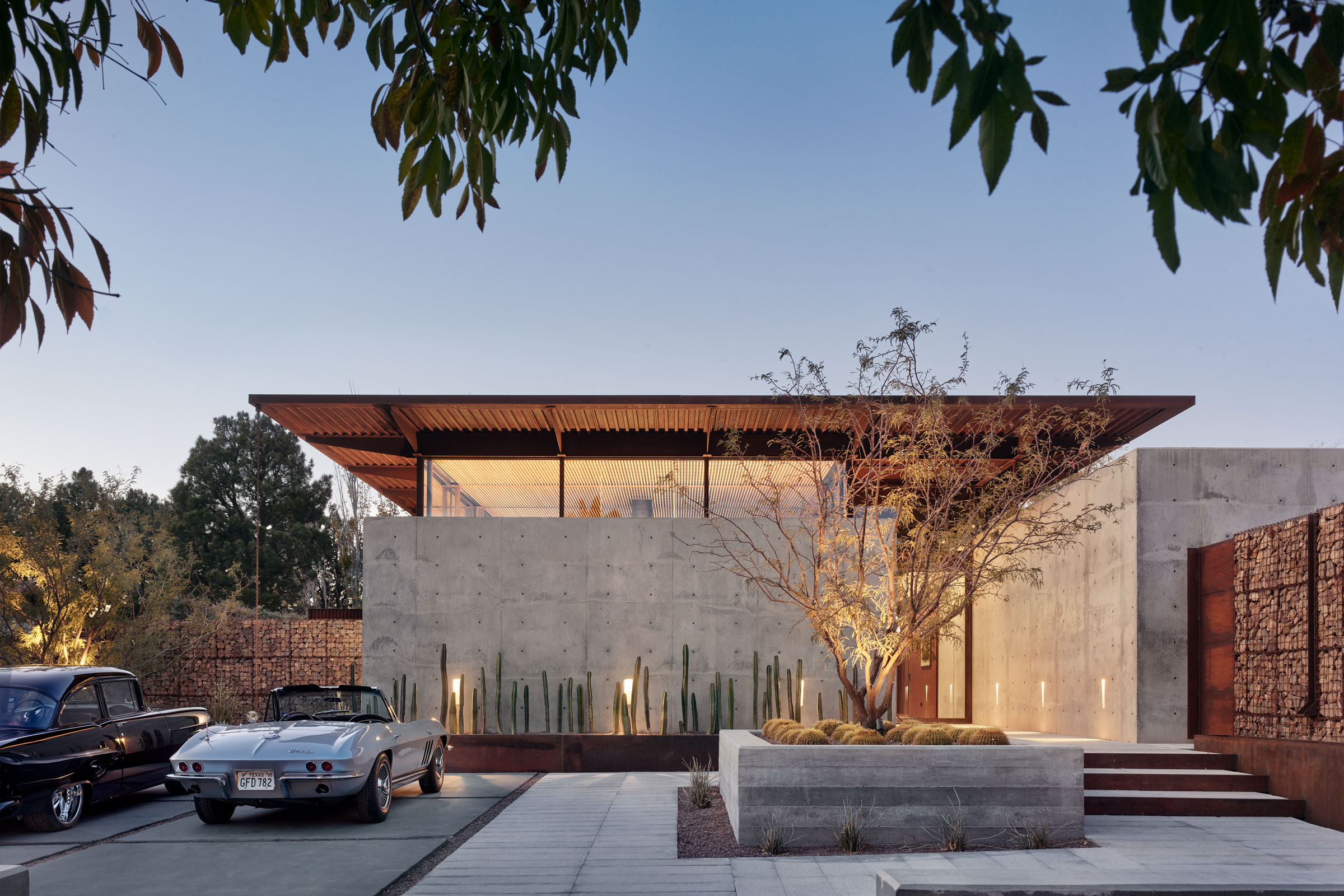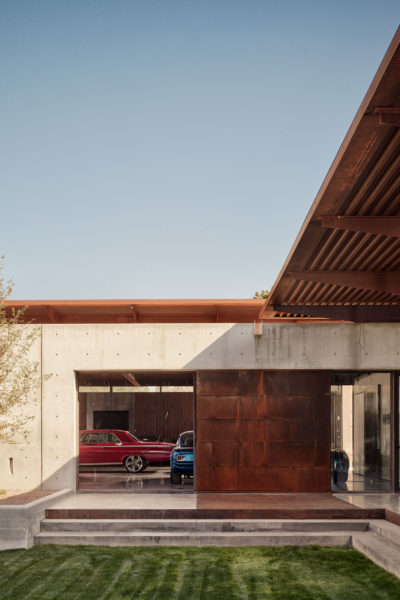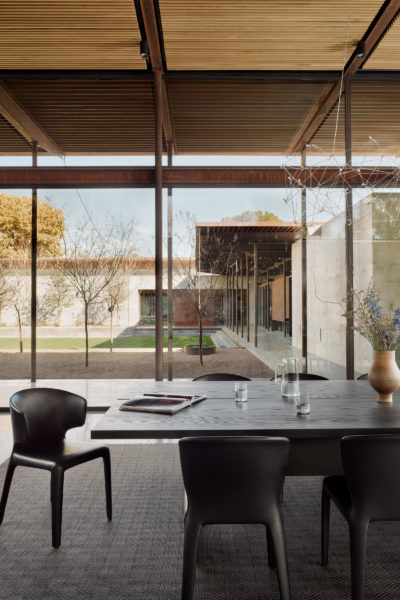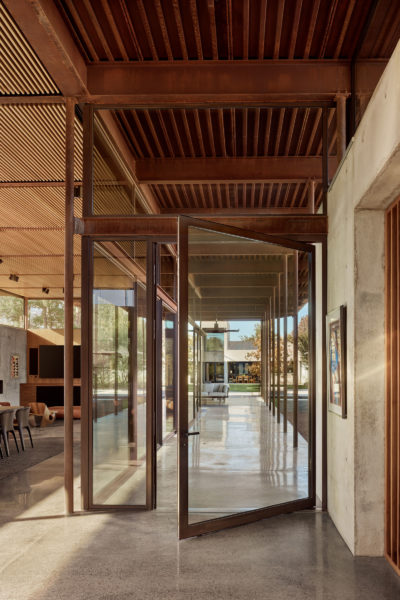Story at a glance:
- This residential design pays homage to the importance of water in the region.
- Concrete and wood combine for a house that’s part exhibit, part home.
- The Courtyard House has plenty of room to entertain, with an outdoor kitchen, pool, and more.
The Courtyard House organizes the family’s activities—a pool, an orchard, an outdoor kitchen, and 8-foot overhangs shading expanses of glass ensure a welcoming vibe. Inside the concrete home, two offices, a home gym, a spa, and a garage for a car collection make a meaningful destination. Interior walls of quarter-sawn walnut and slatted wood ceilings contrast with the harder exterior surfaces.
The home’s materiality—including concrete, stone, and Corten steel—connects the project to the existing home through a large courtyard. The courtyard acts as storm water retention and is defined by gabion walls, which are seen throughout the project to define indoor/outdoor courtyard spaces.
When a family outgrew its original cast-in-place concrete house on El Paso’s west side and the lot in back became available, the homeowners purchased it with the idea of keeping the main house and designing another one behind it where the family of four could entertain.
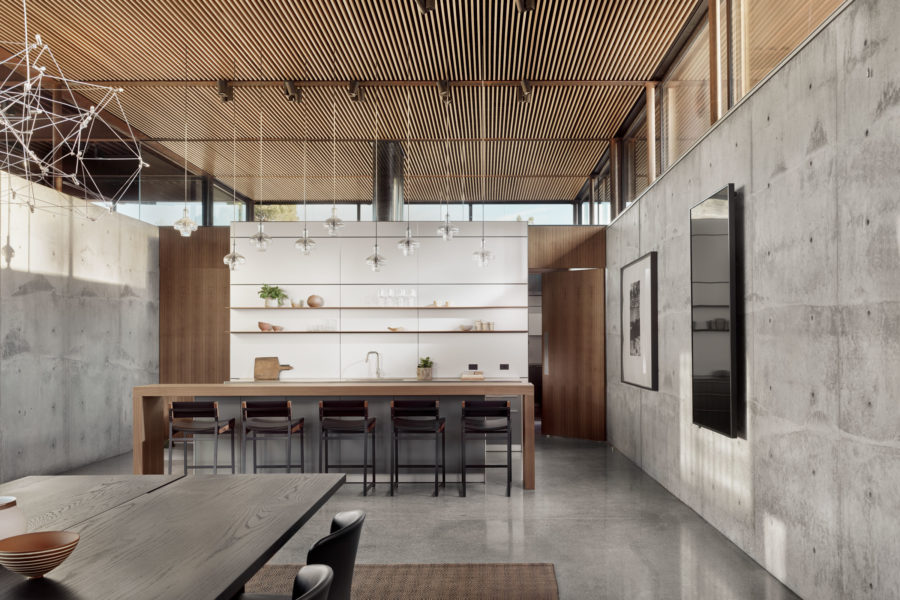
Inside Courtyard House in El Paso. Photo by Casey Dunn
Designed to respond to the context of El Paso’s formidable and diverse topographical personality, the Courtyard House is a place for family to gather and entertain. Sited next to the client’s existing home of cast-in-place concrete, this new addition was envisioned as an entertaining and living space. With the Franklin Mountains as the backdrop and a suburban neighborhood as the immediate context, a large-scale addition was appropriate to the vast setting.
The Courtyard House stands like a mirage in the suburban desert of El Paso, Texas. Designed by Lake|Flato Architects, the sleek concrete building, adorned with Corten overhangs and punctuated by gabion walls, hides an expansive courtyard that both offers refuge from and a celebration of the elements.
- The house includes a pool, outdoor kitchen, and 8-foot overhangs shading expanses of glass. Inside, two offices, a home gym, spa, and garage for a car collection make a meaningful destination. Photo by Casey Dunn
- Designed to respond to the context of El Paso’s formidable and diverse topographical personality, the Courtyard House is a place for family to gather and entertain. Photo by Casey Dunn
One of the most striking parts of the house is a large showroom-garage hybrid that houses the owner’s collection of vintage cars. The pristine, shiny vehicles are displayed in stark contrast to the coppery, industrial doors and rugged concrete interiors of the house, tucked into a cathedral-esque space right off of the main courtyard. Steve Raike, a partner at Lake|Flato, points to the showroom as his favorite moment in the building. “It might be my favorite space, but that’s less about the architecture and more about the cars,” he laughs. “I’m a bit of a car nut.”
His other favorite space? The building’s namesake courtyard. “You’re in this desert environment, but you look out and see this courtyard that feels very verdant. The ability to be in a place like El Paso that’s bright, arid, and sunny and to be able to look out into that courtyard space is just a real treat.”
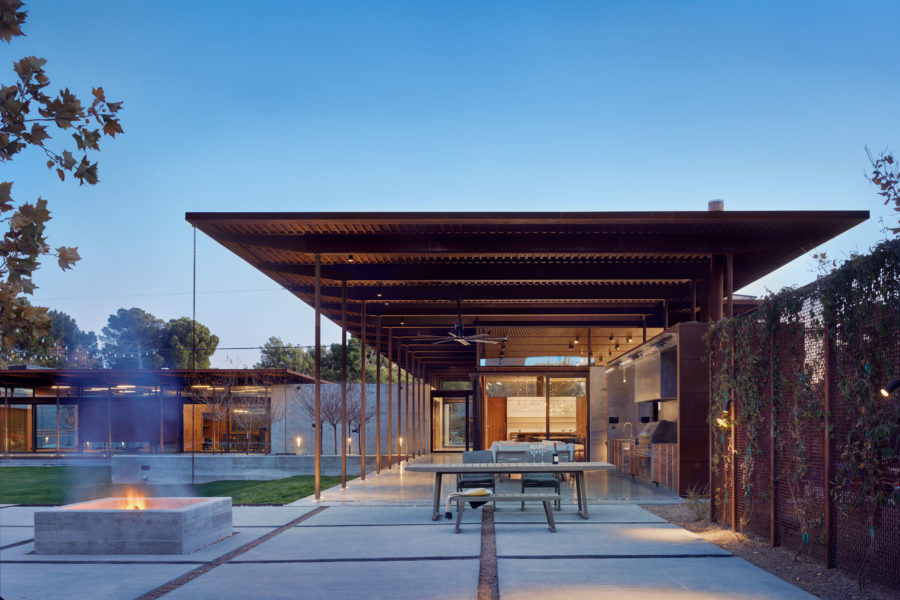
When a family outgrew its original cast-in-place concrete house on El Paso’s west side and the lot in back became available, the homeowners purchased it with the idea of keeping the main house and designing another one behind it where the family of four could entertain. Photo by Casey Dunn
Lake|Flato’s founding design principles revolved around the environment; the firm aims to respond to the site (both built and natural), from landscape to materiality to aesthetics. In the firm’s own words, they “have found the desire to build in partnership with the land to be an approach that remains valid and increasingly resonant.”
In the case of the Courtyard House, water became one of the biggest environmental factors to work with. Where the average annual rainfall in the US is around 38 inches, El Paso gets around a quarter of that. “El Paso is one of the most forward-looking communities in the country with regard to water conservation because it’s a very precious resource for them, and a very scarce resource,” Raike says.
To manage this scarcity, the house’s namesake courtyard and its permeable driveway were designed with a stormwater retention system that has the capacity to retain and then gradually release some 69,000 gallons of water into a groundwater system. “That approach to water permeated other things—a landscape design using drought tolerance and native plant species … right down to the fact that the pool has a retractable cover to limit evaporation,” Raike explains.
Another elemental challenge was relentless sun out in the Chihuahuan Desert. The building has a photovoltaic array installed on roofs that generates 39 kilowatts onsite. Passively, the building was designed with 8-foot overhangs that protect both interior living spaces from the heat and their mechanical systems from overworking.
- Sited next to the client’s existing home of cast-in-place concrete, the new addition at Courtyard House was envisioned as an entertaining and living space. Photo by Casey Dunn
- Interior walls of quarter-sawn walnut and slatted wood ceilings contrast with the harder exterior surfaces. Photo by Casey Dunn
The materiality of the Courtyard House reflect the locale; the overhangs are constructed with Corten steel, a material that’s especially durable in dry climates. They’re supported by slender columns made from oilfield pipes, a nod to industrial Texas, that gives the building a refined but industrial look. The courtyard is defined by gabion walls made with local stone from the Franklin Mountains. “The craftspeople did an amazing job building them,” Raike says, “Watching them work was a real treat; they could just look at a stone and put it in like a jigsaw puzzle.”
If oil fields and the desert landscape all nod to Texan culture, so too does the firm’s approach to sustainability. Raike says Lake |Flato has been designing homes in Texas for more than 35 years.
“I think it’s just a part of our DNA to not only think about water as a precious resource, but also to think of the impact that architecture has on the environment,” he says. “In central Texas, where we do a lot of our work, water is the topic of conversation these days. We have, for a very long time, been designing and trying to look for systems that can treat water with the sort of reverence that we do here in Texas.”

